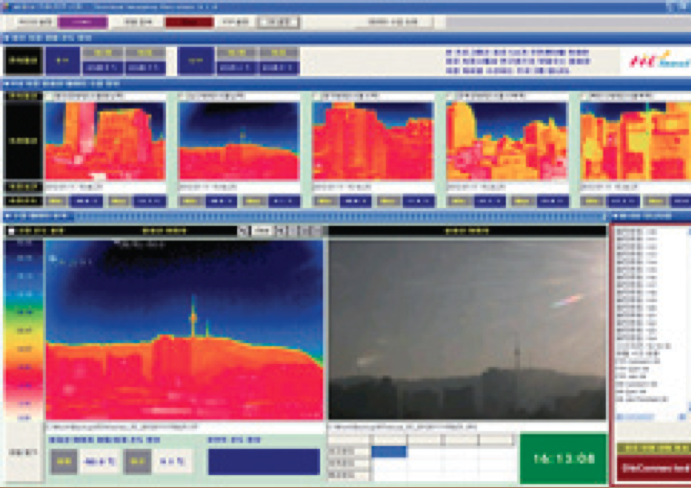空气污染监测网络
Policy Implementation Period
Since the Air Pollution Monitoring Network was first installed and operated in 1973, the government and local government bodies have been operating monitoring networks. At the end of 2014, the Ministry of Environment was operating 148 monitoring network stations while local governments were operating a total of 506 stations in 97 cities and counties in the nation. There were 11 types of air quality monitoring stations (city air quality monitoring station, road-side air quality monitoring station, acid deposition monitoring station, background density monitoring station, suburban air quality monitoring station, heavy metal monitoring station, harmful material monitoring station, photochemical pollutant monitoring station, global atmosphere monitoring station, and monitoring station of PM 2.5 and air pollution concentration).
According to domestic regulations on the installation and operation of the air pollution monitoring network, the air pollution monitoring network is by and large divided into two: the general monitoring network and concentrated monitoring network. There are a total of 10 kinds of general monitoring networks. The stations can be categorized into either the general or special air pollution monitoring network. General air quality monitoring stations check SO2, CO, NOX, O3, and PM10. The stations are then further categorized into national or local, depending on the type of operation.
According to domestic regulations on the installation and operation of the air pollution monitoring network, the air pollution monitoring network is by and large divided into two: the general monitoring network and concentrated monitoring network. There are a total of 10 kinds of general monitoring networks. The stations can be categorized into either the general or special air pollution monitoring network. General air quality monitoring stations check SO2, CO, NOX, O3, and PM10. The stations are then further categorized into national or local, depending on the type of operation.
Figure 1: Categorization of Domestic Air Pollution Monitoring Network
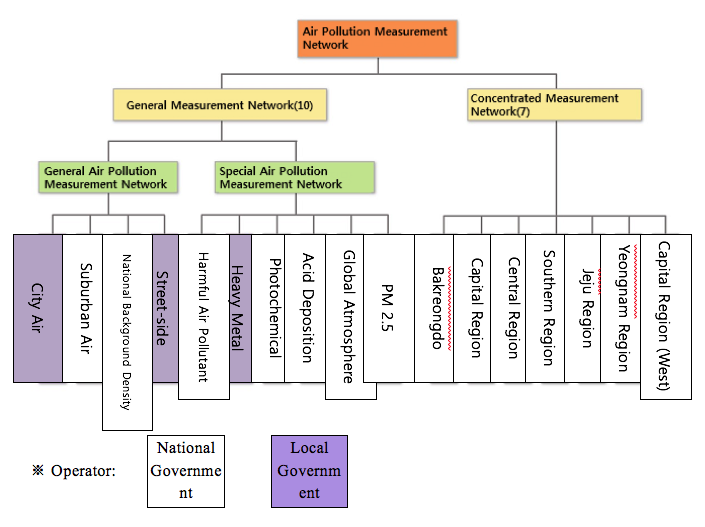
*Source: Ministry of Environment, Air Pollution Monitoring Network Installation and Operation Manual, 2011
Seoul City began with 4 monitoring stations in 1973. Currently, there are 45 monitoring stations, operating 65 air pollution monitoring networks. 25 districts are categorized into central, northeast, northwest, southwest, southeast areas for air pollution analysis and management. There is at least 1 or more monitoring network installed for operation for each district. Among the 6 types of monitoring networks, the following monitoring stations have been recorded: 25 city, 14 road-side, 10 photochemical, 5 heavy-metal, 10 acid deposition and 1 visible distance monitoring station. The listed order is according to the number of stations.
Table 1. Seoul City Air Pollution Monitoring Network Operation (2015)
| Category | Total | City | Street-side | Photo chemical |
Heavy Metal |
Acid Deposition | Visible Distance |
| Total | 65 | 25 | 14 | 10 | 5 | 10 | 1 |
Source: Seoul City Air Management Department
Figure 2. Seoul Air Pollution Monitoring Network Distribution Status
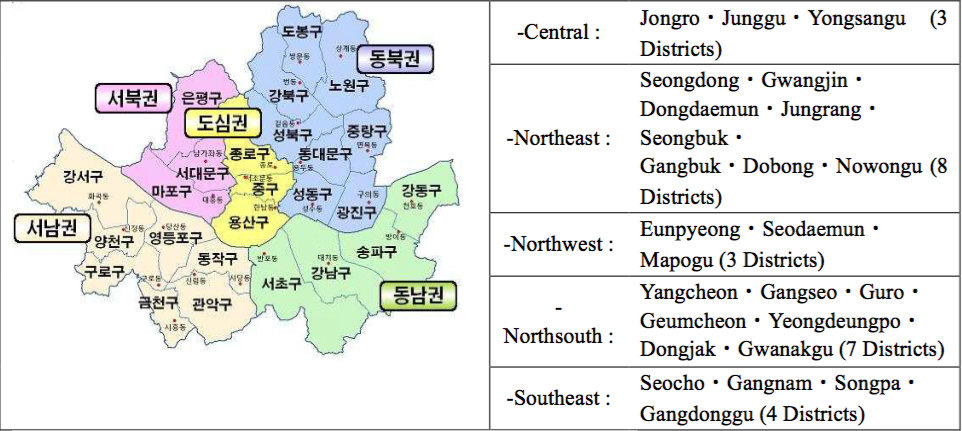
Seoul's air pollution monitoring stations have been operated with the following number of stations until 2008: 27 city monitoring networks, 2 clean zone, and 9 road-side networks. As Seoul islargely affected by Seoul Metropolitan areas as well as China and the northwest monsoon, the monitoring networks have been re-organized in order to better understand and manage pollutants that travel long distances, the components, density and travel routes, pollutant statistics in border areas, and road-side pollutant statistics. Seoul city currently has 25 stations, 1 for each district. The city also operates 6 background monitoring networks: Gwanak Mountain station has been installed to measure pollutants that travel long distances, Namsan station for that of high altitude, and Bukhansan station to understand the air quality of the clean zone. Moreover, to manage the generational and changing statistics of pollutants from automobiles, 12 stations have been installed on expressways. More stations have been installed for exclusive median bus lanes and exclusive car lanes. There are a total of 14 road-side air pollution monitoring stations being currently operated. Therefore, Seoul City is operating a total of 45 stations (25 city stations, 6 background, 14 street-side) for the monitoring and management of air pollution.
Table 2. Seoul City General and Special Air Pollution Monitoring Network Station Status
| Category | General and Special Air Pollution Monitoring Network | ||||||||||||
| General Air | Heavy Metal | VOC/BTEX | Acid Rain | Mercury | Ion | EC/OC | BC | PM-1 | Traffic Volume | HC | UV | ||
| City Air Quality Monitoring Station | 25 | 4 | 7 | 8 | 4 | 3 | 3 | 4 | |||||
| Road-side Air Quality Monitoring Station | 14 | 4 | 1 | 2 | 3 | 15 | 9 | ||||||
| City Background Monitoring Station | 6 | 1 | 1 | 1 | 1 | 1 | 4 | ||||||
| Other (Researcher) | 1 | 1 | 1 | ||||||||||
| Mobile Air Quality Monitoring Vehicle (6 Units) | 1 | 1 | |||||||||||
| Total | 47 | 5 | 12 | 10 | 5 | 4 | 5 | 2 | 8 | 3 | 15 | 10 | |
Air pollution monitoring stations are located in various areas around Seoul which are said to best represent each area's specific and idiosyncratic characteristic. The monitoring stations automatically measure air quality 24 hours a day. These results are then sent to the Seoul Public Health and Environment Research Institute, and released to the general public and citizens of the city through its website. The measured values are sent to Seoul City and the Ministry of Environment after a thorough search process. In order to enhance credibility of values, only the statistics that have achieved more than 75% measured values during the designated period are considered to be valid.
Therefore, Seoul uses the measured air pollution statistics to forecast situations and warn the citizens on air pollution, evaluate air quality, and find ways to improve the air quality. The city will continue to build new monitoring stations, change aged facilities, add cutting-edge monitoring facilities and push for an integrated information system for air environment, so as to ultimately create the most trustworthy air quality management system.
Figure 3. Air Quality Pollution Monitoring Station Locations
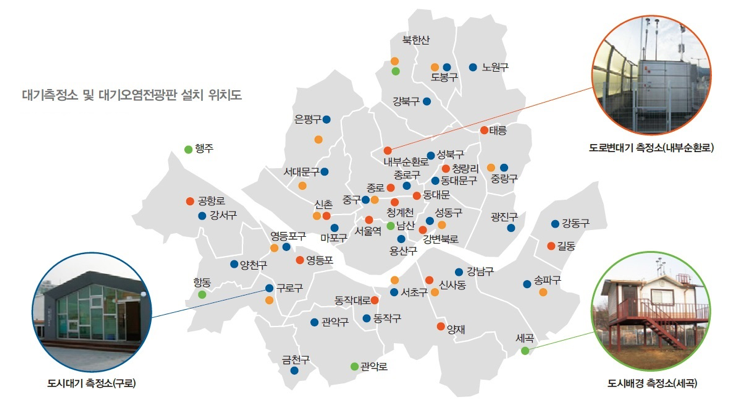
Reference: Seoul Policy Archive
Background Information
Korea has achieved and undergone periods of rapid industrialization and urbanization since 1960s and this has been reflected in the almost incomparable economic growth it has also demonstrated. At the same time, the air quality of urban and industrial areas has deteriorated. More specifically, urban areas which have recorded rapid growth in terms of population have also seen increases in heating fuel consumption and automobile use; these have resulted in an increasing volume of air pollutants generated. Moreover, the situation is worsening by the day.
Air pollution in Korean metropolises continued to deteriorate over time and finally reached a point at which it couldn’t be overloooked; therefore, various actions were required to improve such a situation. The Environmental Conservation Act was enacted in 1978, and the Environmental Office was created in 1980. A number of actions and policies began to be considered.
Seoul Metropolitan Government (SMG) also went forward to improve air quality by expanding the provision of low sulfur fuel and other clean fuels, or by attaching purifiers to automobiles. However, the density of 1st pollutants exceeded general air environment standards.
To check Seoul's air quality and analyze pollution, air quality had to be measured at several locations at the same time. Therefore, SMG installed the automatic air quality pollution monitoring network. The city started to measure air quality in real-time. An air pollution alert system has been created to provide forecasts and warn the citizens so as to protect their health as the air quality can have a considerable impact. Moreover, the measured air pollution statistics are used in various ways, such as analyzing to evaluate air pollution prevention policies, evaluations to understand whether the environmental standards have been met, providing information for forecast models or air pollution trend analysis.
Air quality pollution monitoring stations are located in various areas around Seoul which are said to best represent each area's specific and idiosyncratic characteristic. The monitoring stations automatically measure air quality 24 hours a day. These results are then sent to the Seoul Public Health and Environment Research Institute, and released to the general public and citizens of the city through its website. The measured values are sent to SMG and the Ministry of Environment after a thorough search process. In order to secure trustworthy values, only the statistics that have achieved more than 75% measured values during the designated period are considered to be valid.
Air pollution in Korean metropolises continued to deteriorate over time and finally reached a point at which it couldn’t be overloooked; therefore, various actions were required to improve such a situation. The Environmental Conservation Act was enacted in 1978, and the Environmental Office was created in 1980. A number of actions and policies began to be considered.
Seoul Metropolitan Government (SMG) also went forward to improve air quality by expanding the provision of low sulfur fuel and other clean fuels, or by attaching purifiers to automobiles. However, the density of 1st pollutants exceeded general air environment standards.
To check Seoul's air quality and analyze pollution, air quality had to be measured at several locations at the same time. Therefore, SMG installed the automatic air quality pollution monitoring network. The city started to measure air quality in real-time. An air pollution alert system has been created to provide forecasts and warn the citizens so as to protect their health as the air quality can have a considerable impact. Moreover, the measured air pollution statistics are used in various ways, such as analyzing to evaluate air pollution prevention policies, evaluations to understand whether the environmental standards have been met, providing information for forecast models or air pollution trend analysis.
Air quality pollution monitoring stations are located in various areas around Seoul which are said to best represent each area's specific and idiosyncratic characteristic. The monitoring stations automatically measure air quality 24 hours a day. These results are then sent to the Seoul Public Health and Environment Research Institute, and released to the general public and citizens of the city through its website. The measured values are sent to SMG and the Ministry of Environment after a thorough search process. In order to secure trustworthy values, only the statistics that have achieved more than 75% measured values during the designated period are considered to be valid.
Figure 4. SMG’s Air Quality Pollution Statistics Management System
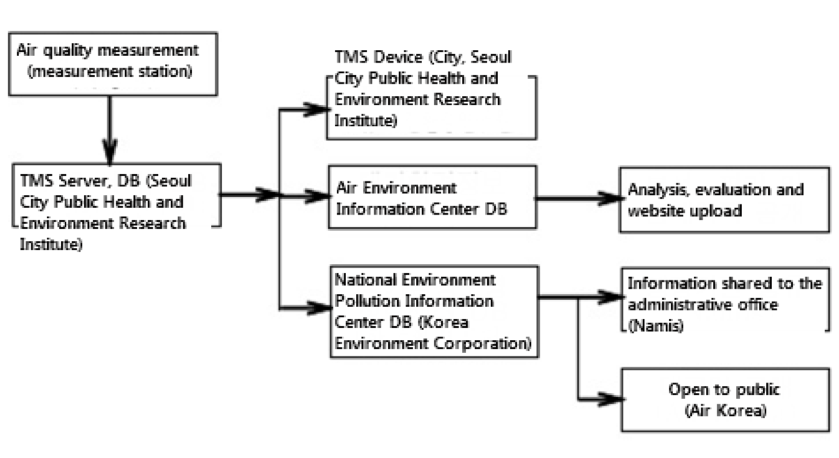
The Importance of the Policy
The aim of a constant watch on air pollution had been about understanding the daily, monthly and seasonal changes, evaluating if the environmental standards have been met, and understanding long term change trends. However, the air pollution real-time monitoring statistics are being used as part of a forecast warning system to protect citizens' health, as part of the plans to protect the environment, the evaluation of environmental impacts, city planning, and traffic planning. The statistics are being used as important data for evaluation before and after policy planning.
SMG began installing and operating monitoring stations starting from late 1970s, in order to watch air pollutants and track the density changes in air pollutant. In the 1980s, semiautomatic monitoring facilities were mostly used to observe pollutants. Starting from the late 1990s, semiautomatic stations closed and now automatic facilities are mainly being used.
In the 1990s, secondary pollutants such as acid rain, ozone, or photochemical smog became a new issue for air pollution. The stations were then categorized into two types: standard air quality monitoring network or special air quality monitoring station, with "2000s Air Quality Monitoring Network Plans." The plans are modified every 5 years after then, reflecting new needs for air quality monitoring. Other than the standard materials, monitoring networks are added for environmentally important pollutants in order to more successfully develop air quality monitoring.
SMG began installing and operating monitoring stations starting from late 1970s, in order to watch air pollutants and track the density changes in air pollutant. In the 1980s, semiautomatic monitoring facilities were mostly used to observe pollutants. Starting from the late 1990s, semiautomatic stations closed and now automatic facilities are mainly being used.
In the 1990s, secondary pollutants such as acid rain, ozone, or photochemical smog became a new issue for air pollution. The stations were then categorized into two types: standard air quality monitoring network or special air quality monitoring station, with "2000s Air Quality Monitoring Network Plans." The plans are modified every 5 years after then, reflecting new needs for air quality monitoring. Other than the standard materials, monitoring networks are added for environmentally important pollutants in order to more successfully develop air quality monitoring.
Policy Objectives
Through "2011-2015 Air Quality Monitoring Network Operation Plan," SMG adjusted operating system of the monitoring networks' according to the measured pollutants and size of the stations. Thus, the overall management was able to become more systematic and efficient.
The major overall direction is to automatically operate general networks without human resources so the general, special and comprehensive networks can be operated more efficiently. For comprehensive stations, there must be multiple facilities placed in the same location, and the facilities must be able to measure more than 2 pollutants.
Air pollutant concentration monitoring stations are operated for the better understanding of the air quality of the major areas, component analysis, and to find the causes of the pollutants. The stations include in-depth monitoring and research functions.
Moreover, SMG is strengthening its management on harmful pollutants such as PM2.5 or mercury. The networks have been expanded to include both density monitoring networks and component monitoring networks for PM2.5. This is to secure base materials to help decide policy directions and evaluate whether or not the material has reached environmental standards, as PM2.5 was finally included as part of the environmental standard elements in 2015. Also, previous pollutant monitoring elements have been adjusted to enable mercury monitoring, since the material requires management and regulations. SMG has installed a total of 4 mercury monitoring facilities in 2015. To strengthen harmful heavy metal monitoring, the city has included fine dust in sampling collection at the heavy metal monitoring stations and added arsenic and beryllium.
The major overall direction is to automatically operate general networks without human resources so the general, special and comprehensive networks can be operated more efficiently. For comprehensive stations, there must be multiple facilities placed in the same location, and the facilities must be able to measure more than 2 pollutants.
Air pollutant concentration monitoring stations are operated for the better understanding of the air quality of the major areas, component analysis, and to find the causes of the pollutants. The stations include in-depth monitoring and research functions.
Moreover, SMG is strengthening its management on harmful pollutants such as PM2.5 or mercury. The networks have been expanded to include both density monitoring networks and component monitoring networks for PM2.5. This is to secure base materials to help decide policy directions and evaluate whether or not the material has reached environmental standards, as PM2.5 was finally included as part of the environmental standard elements in 2015. Also, previous pollutant monitoring elements have been adjusted to enable mercury monitoring, since the material requires management and regulations. SMG has installed a total of 4 mercury monitoring facilities in 2015. To strengthen harmful heavy metal monitoring, the city has included fine dust in sampling collection at the heavy metal monitoring stations and added arsenic and beryllium.
Relevance with Other Policies
SMG provides measured air pollution monitoring information to the citizens through various media channels such as the Seoul Air Environment Information (http://cleanair.seoul.go.kr), YTN weather or Mobile Seoul. This is to protect citizens' health and promote the awareness of environmental preservation, taking the role of both promoting the city's policies and that of an environmental watcher.
 Figure 5. Seoul Air Environment Information Service Website
Figure 5. Seoul Air Environment Information Service Website
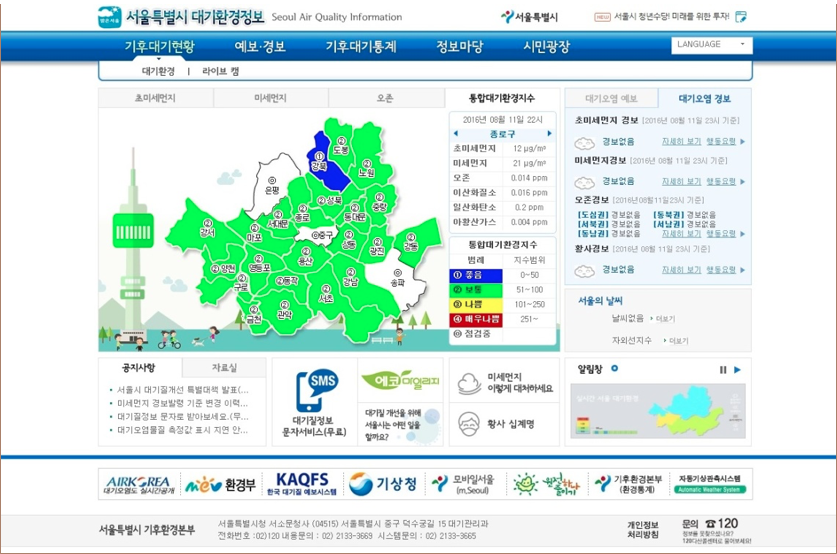
The Seoul Air Quality Information Service shows air pollution on a map for each district and with quality levels represented by color. People are able to sort the results for each monitoring station, area, pollutant types and duration of time.

Moreover, as well as protecting citizens' health and minimizing danger to the living environment, the data is being utilized for forecasting and warning of air pollutants (finedust, ozone), as well as being used as a much larger basic data to better understand air pollution and to build air quality improvement policies.
1) Fine Dust Forecast ・Warning System
Air pollution materials obtained from air pollution monitoring stations are used for air pollution warnings and the forecasting system in order to protect the citizens' health. The fine dust forecast is designed to inform the citizens when high density levels are expected. The warning is to measure the statistics in real-time and notify the citizens quickly when air pollution reaches serious levels. The system aims to protect the citizens, especially those with respiratory diseases, children or elderly citizens that are more sensitive to air pollution.
The microdust forecast and warning system is based on the rapid increase of automobiles, and the influx of high-density microdust from China. The system is to promote citizens' participation by notifying them how to act at such times, and then recommend the use of public transportation. Companies that emit such pollutants can also shorten their operation.
Air pollution forecasts are divided into 5 levels: good, ordinary, slightly bad, bad, and very bad. Forecasts are provided at 6 p.m. the previous day and 7 a.m. on the same day.
The microdust forecast and warning system is based on the rapid increase of automobiles, and the influx of high-density microdust from China. The system is to promote citizens' participation by notifying them how to act at such times, and then recommend the use of public transportation. Companies that emit such pollutants can also shorten their operation.
Air pollution forecasts are divided into 5 levels: good, ordinary, slightly bad, bad, and very bad. Forecasts are provided at 6 p.m. the previous day and 7 a.m. on the same day.
Table 3. Fine Dust Forecast System in Korea and Guide for Citizens
| Category | Alert Level for Fine Dust Density (㎍/㎥) | |||||
| Good | Ordinary | Slightly Bad | Bad | Very Bad | ||
| Forecast Material |
PM10 | 0~30 | 31~80 | 81~120 | 121~200 | Higher than 201 |
| PM2.5 | 0~15 | 16~50 | 51~75 | 76~100 | Higher than 101 | |
| Action Guide |
Sensitive Group | - | Outdoor activity with caution, according to health conditions | Refrain from prolonged hard outdoor activity | Refrain from hard outdoor activity (People with respiratory disease, heart disease, elderly citizens) |
Restrict outdoor activity |
| General Citizen | - | - | Refrain from prolonged hard outdoor activity | Refrain from outdoor activity | ||
| *Permissible Level of Fine dust PM10 : 24 hours 100㎍/㎥, annual 50㎍/㎥, PM2.5 : 24 hours 50㎍/㎥, annual 25㎍/㎥ *Sensitive Group: Children, elderly, adult with respiratory or heart disease |
||||||
When the forecast is worse than 'slightly bad,' hospitals and senior citizen centers are notified. The elderly, children, and people with respiratory diseases are warned against outdoor activities or exercise. When it is higher than 'bad', citizens are warned against using automobiles and microdust generating businesses are encouraged to adjust their operation. When it is higher than 'very bad,' the superintendent is notified so as to protect children and students' health. They are warned against outdoor classes, and recommended to shorten school hours or have a day off.
Table 4. Details of FineDust Alert System in Korea
| Target Material | Alert Level | On Standard | Off Standard |
| PM10 | Watch | Considering the weather factors, when automatic monitoring station's hourly PM10 density is higher than 150㎍/㎥ for more than 2 hours. | Considering the weather factors in areas that already have 'watch' signal, when automatic monitoring station's hourly PM10 density is lower than 100㎍/㎥. |
| Warning | Considering the weather factors, when automatic monitoring station's hourly PM10 density is higher than 300㎍/㎥ for more than 2 hours. | Considering the weather factors in areas that already have 'watch' signal, when automatic monitoring station's hourly PM10 density is lower than 150㎍/㎥, then 'warning' changes to 'watch'. | |
| PM2.5 | Watch | Considering the weather factors, when automatic monitoring station's hourly PM2.5 density is higher than 90㎍/㎥ for more than 2 hours. | Considering the weather factors in areas that already have 'watch' signal, when automatic monitoring station's hourly PM2.5 density is lower than 50㎍/㎥. |
| Warning | Considering the weather factors, when automatic monitoring station's hourly PM2.5 density is higher than 180㎍/㎥ for more than 2 hours. | Considering the weather factors in areas that already have 'watch' signal, when automatic monitoring station's hourly PM2.5 density is lower than 90㎍/㎥ then 'warning' changes to 'watch'. |
When real-time statistics at the air quality monitoring network shows a higher density than the standard, watch and warning signals are sent to recommend citizens against outdoor activities or classes. The schools are encouraged to take a day off. Citizens are also encouraged against using automobiles. Dust-generating businesses are advised to stop operating, and the roads are cleaned with water.
Figure 6. Seoul Fine Dust Forecast ・ Warning Dissemination System
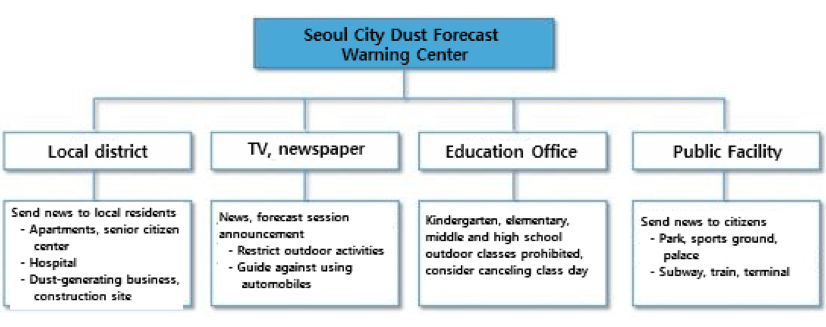
When the microdust forecast is 'bad' or 'very bad,' SMG recommends against outdoor activities for children, the elderly, or people with respiratory disease. When outdoor activity is unavoidable, citizens are encouraged to wear hygienic masks, and use the 'Neighborhood Air Quality' mobile application to get updates on microdust statistics. Moreover, the citizens are encouraged to use public transportation such as buses or subways whenever possible, to reduce microdust generation.
Figure 7. Guide for Citizens under Microdust Watch or Warning
| Fine Dust Watch | Microdust Warning |
| Sensitive group is recommended to restrict outdoor activity and stay indoors General public is recommended to limit prolonged or intense outdoor activity (especially when there is pain in eyes, cough or sore throat) In case of outdoor activity, wear yellow dust (protective) mask (for people with lung disease, consult with doctor before using) Try not to go to areas with large traffic Limit outdoor classes at kindergarten and elementary school Restrict public outdoor sports facilities Guide to restrict intense outdoor activities to citizens at park, sports facility, palace, terminal, train and subway |
For sensitive group, prohibit outdoor activity (consult with doctor before going outside) For general public, restrict prolonged or intense outdoor activity (stay indoors if experiencing cough or sore throat) In case of outdoor activity, wear yellow dust (protective) mask Do not go to areas with large traffic Prohibit outdoor classes at kindergarten and elementary school, shorten school hours or cancel class day Limit outdoor classes at middle and high school Stop operating public outdoor sports facilities Guide to limit intense outdoor activities to citizens at park, sports facility, palace, terminal, train and subway |
Figure 8. Neighborhood Air Quality Mobile App
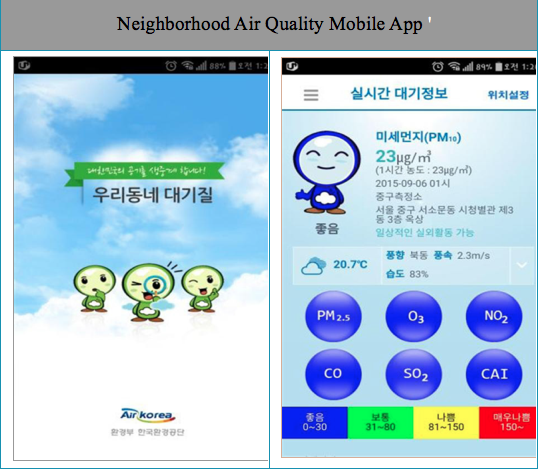
When microdust forecasts levels are higher than 'bad' (81㎍/㎥), the citizens are recommended to follow the guides as shown in <Figure 9>
Figure 9. Rules for Citizen's Health when Microdust Density is High

2) Downtown Thermal Image released on the web
Since February 2009, the temperature of Seoul’s downtown area has been measured in real-time at the Jongrogu air pollution monitoring station with a thermo-graphic camera. The measured thermal image of the downtown is released to the public at the Seoul City Air Environment Information (http://cleanair.seoul.go.kr). Based on the Jongrogu air pollution monitoring station, the temperatures in 5 directions (Namsan, Dongdaemun, Jonggak, Gyeongbokgung, Bukhansan) are measured every 10 minutes. The results are displayed in colored images, starting from white to blue, so that the temperature can be understood at a glance.
Large cities like Seoul demonstrate a thermal island effect which means the downtown area shows higher temperatures than other part of the city. Surface temperatures of buildings could increase up to 59℃ (August 8 2014), which is about a 30℃ difference from the highest temperature, 30.3℃. This thermal island effect is due to the changed surface heat balance of buildings and roads, the increase of automobiles and fuel use that generates heat, the increase of air pollutants, and the greenhouse effect from pollutants covering the city's atmosphere, and skyscrapers that prevent the wind from blowing.
Figure 10. Display Status of City's Thermal Image
Figure 11. Jongrogu Station's Thermo-graphic Camera

3) The Operation of Seoul Ozone Forecast ・ Warning System
SMG commenced the ozone warning system in May 1st 1995, which was the first of its kind in Korea. The city operates an ozone forecast and warning system from May 1st to September 15th every year to minimize its impact on the human body or the living environment. On the previous day, the information is sent via SMS at 6 p.m. and uploaded to the environmental information website. The same-day forecast is sent in the same manner at 9 a.m.


Figure 12. Seoul Ozone Forecast ・ Warning System Standard and Operation System
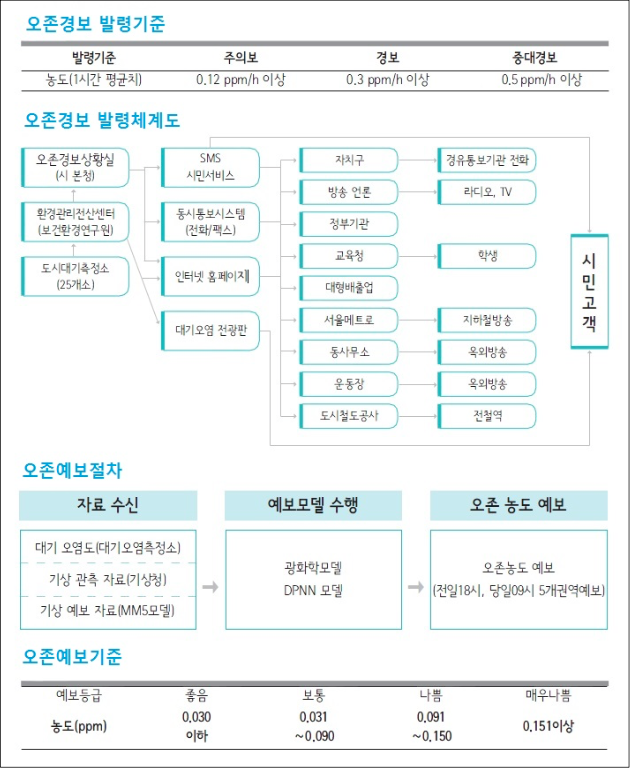
The ozone forecast and warning system included central areas since 2011 has categorized the city into 5 regions: central, northeast, northwest, southwest and southeast. When the ozone warning is on, the air environment information electronic board and SMG's commercial electronic board, broadcast media and the internet are used to inform the citizens. The elderly are warned against outdoor activities, and the citizens are encouraged to use public transportation.
4) Air Pollution Information Electronic Display Board (13 locations)
Seoul City has been operating the Banpo and Seongsu Air Pollution Information Electronic Display Board since December 1992, and took over the operation of the Air Pollution Information Electronic Display Board of the SMG and Munrae from May 1993. The display board of the SMG and Munrae were originally installed and operated by the Ministry of Environment. The Air Pollution Information Electronic Display Board utilizes the statistics gained from automatic monitoring networks to display air quality information in various numbers so as to protect the citizens and promote awareness about the environment. It also promotes environmental policies and serves as environmental watcher.
Density of designated pollutants are displayed in real-time, including . Environment-related promotions and guides for citizens regarding ozone or microdust warnings are also displayed.
Density of designated pollutants are displayed in real-time, including . Environment-related promotions and guides for citizens regarding ozone or microdust warnings are also displayed.
 Figure 13. Air Environment Information Electronic Display Example
Figure 13. Air Environment Information Electronic Display Example
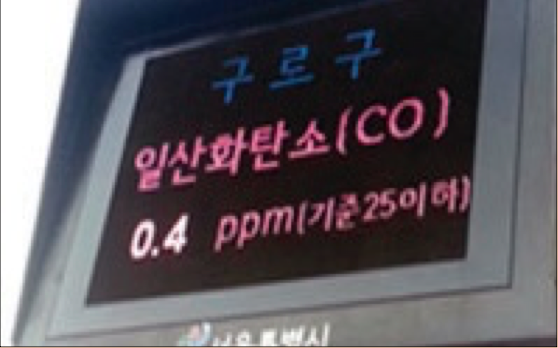
5) N Seoul Tower Lighting Microdust Information Service
SMG also informs pollution levels with Namsan Seoul Tower's lighting, so the citizens are able to be informed and stay up-to-date quickly and easily. Beginning in May 2011, the tower's light is blue when the air quality is good, and red when the air quality is bad. Different colors are displayed according to the condition. The service starts after sunset, until 10 p.m. (until 11 p.m. for April to September). Recently, SMG changed its standard of 'good air day' to PM2.5 from PM10 starting from 2015 February. This is since the SMG declared its intention to reduce ultrafine particles by 20% by 2018.


Figure 14. N Seoul Tower Informing Microdust Levelwith Lighting Color
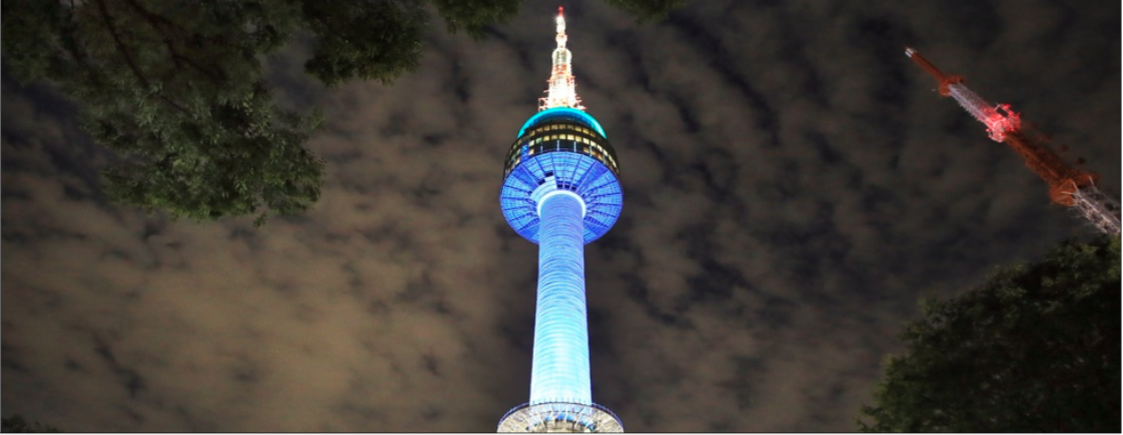
Figure 15. 4 Fine Dust Level and the color of Seoul N Tower Lighting

Main Policy Contents
From the 1990s, SMG has continuously sought the improvement in monitoring network through 3 plans: 2 basic ones by the Ministry of Environment's air pollution monitoring network operation plans, and additional operation plans. The number of monitoring stations increased rapidly while the system was being organized. The city started with 4 stations in 1973, and as of 2015, there are now 45 stations.
1) City Air Quality Monitoring Network
The stations are operated to measure highly populated areas' air pollution level or whether the statistics met environment standards. This is to be utilized for both improving the air quality or policymaking. Each city monitoring station checks 10 basic elements – SO2, CO, NOx, PM10, PM2.5, O3, wind direction, wind speed, temperature, and humidity.
According to the Installation and Operation Manual of the Air Quality Monitoring Network (2006), city air monitoring stations are to be installed at "locations where the average air quality can be checked, while not directly affected by major pollutant generator." The location is selected at a place that can best represent the area, and where there are no buildings, trees or plants that block the facilities. In situations in which there are buildings, plants or trees around the station, a sampling station must be located where the distance to the object is more than twice the height of object, or where the straight line that connects the sample port and the top of the object is less than 30° to the horizontal line. When buildings are concentrated in the area, a sampling station should be installed at least 1.5m away from building surfaces. The sampling station's height must be within 1.5~10m, and where the representative value of the area can be obtained.
Seoul's air monitoring station is located in across Seoul at approximately 5km away from each other according to TM coordinate system. They are located away from major roads so that major pollutant generators (automobiles) cannot directly affect the statistics. Generally, they are located on top of community centers or public offices.

According to the Installation and Operation Manual of the Air Quality Monitoring Network (2006), city air monitoring stations are to be installed at "locations where the average air quality can be checked, while not directly affected by major pollutant generator." The location is selected at a place that can best represent the area, and where there are no buildings, trees or plants that block the facilities. In situations in which there are buildings, plants or trees around the station, a sampling station must be located where the distance to the object is more than twice the height of object, or where the straight line that connects the sample port and the top of the object is less than 30° to the horizontal line. When buildings are concentrated in the area, a sampling station should be installed at least 1.5m away from building surfaces. The sampling station's height must be within 1.5~10m, and where the representative value of the area can be obtained.
Seoul's air monitoring station is located in across Seoul at approximately 5km away from each other according to TM coordinate system. They are located away from major roads so that major pollutant generators (automobiles) cannot directly affect the statistics. Generally, they are located on top of community centers or public offices.

Figure 16. City Air Qualityn Monitoring Network Locations
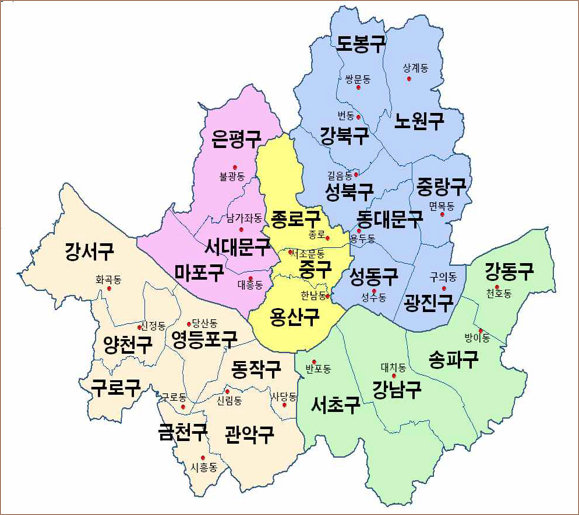
2) Road-side Air Quality Monitoring Network
Road-side stations are located in places on roads that have the largest amount of traffic in Seoul, so as to monitor components of exhaust fumes. There are 14 monitoring networks installed. SMG's 14 stations collect pollutants from the roadside air from automatic monitoring facilities. The collected data is then used to evaluate roadside air pollution and the impact on the environment. The materials are used as the main basis for policies for Seoul's roadside air quality. There are 10 stations at street-side, 2 at exclusive car lanes, and 2 at median strip.
The road-side stations measure 17~20 elementsincluding sulfurous acid gas. There are 13 air pollutants (NO, NO2, NOX, O3, CO, CH4, n-CH4, THC, SO2, TSP, PM10, PM2.5, EC/OC), 6 weather factors (wind direction, wind speed, temperature, humidity, UV radiation, solar radiation) and the amount of traffic. The statistics are sent in real-time to the Electronic Control Center of the Seoul Metropolitan Government Research Institute of Public Health and Environment, the Seoul Metropolitan GovernmentWeather and Environment Center, the National Institute of Environmental Research of the Ministry of Environment and Gyeongin Regional Environmental Office.



The road-side stations measure 17~20 elementsincluding sulfurous acid gas. There are 13 air pollutants (NO, NO2, NOX, O3, CO, CH4, n-CH4, THC, SO2, TSP, PM10, PM2.5, EC/OC), 6 weather factors (wind direction, wind speed, temperature, humidity, UV radiation, solar radiation) and the amount of traffic. The statistics are sent in real-time to the Electronic Control Center of the Seoul Metropolitan Government Research Institute of Public Health and Environment, the Seoul Metropolitan GovernmentWeather and Environment Center, the National Institute of Environmental Research of the Ministry of Environment and Gyeongin Regional Environmental Office.



Figure 17. Road-side Monitoring Station /Figure 18. Exclusive Car Lane Monitoring Station /Figure 19. Median Strip Monitoring Station

3) Heavy Metal Monitoring Network
Heavy metal monitoring networks are operated to measure heavy metal densityto understand environmental impact, or to come up with policy to control harmful heavy metal. The stations measure the density of heavy metals, such as lead (Pb), cadmium (Cd), and chrome (Cr).
Mercury is measured every 24 hours by automatic facilities at Guro, Bangi, Nowon and Hannam. Heavy metals in the air can be discharged from various locations, both artificial and natural. Usually, they are attached to dust and stay in the air. Even small amounts can harm the human body.
Samples are collected every second week of the month (24 hours), and every day during the yellow dust season. A High Volume Air Sampler is used to collect sampling, and starting from January 2013, the sampling method has changed from TSP to PM10.
During regular investigation, a total of 19 elements are measured: lead (Pb), cadmium (Cd), chrome (Cr), copper (Cu), manganese (Mn), iron (Fe), nickel (Ni), arsenic (As), and beryllium (Be). During the yellow dust season, aluminum (Al), calcium (Ca), magnecium (Mg) are added to the regular list. Inductive coupling plasma emission spectroscopy is used as the analysis method.
Mercury is measured every 24 hours by automatic facilities at Guro, Bangi, Nowon and Hannam. Heavy metals in the air can be discharged from various locations, both artificial and natural. Usually, they are attached to dust and stay in the air. Even small amounts can harm the human body.
Samples are collected every second week of the month (24 hours), and every day during the yellow dust season. A High Volume Air Sampler is used to collect sampling, and starting from January 2013, the sampling method has changed from TSP to PM10.
During regular investigation, a total of 19 elements are measured: lead (Pb), cadmium (Cd), chrome (Cr), copper (Cu), manganese (Mn), iron (Fe), nickel (Ni), arsenic (As), and beryllium (Be). During the yellow dust season, aluminum (Al), calcium (Ca), magnecium (Mg) are added to the regular list. Inductive coupling plasma emission spectroscopy is used as the analysis method.
4) Mercury Monitoring Network
Mercury is the only liquid metal at room temperature, and it is accumulated through earth, water and air. In particular, air is a very important means for the material. More than 98% of mercury in the atmosphere is gas, which circulates around the earth, accumulates and reacts when it enters the ecosystem. It is very important to monitor mercury in real-time.
SMG is monitoring mercury level in the air at 4 stations, and the measured values are used as the basis for related policies.

SMG is monitoring mercury level in the air at 4 stations, and the measured values are used as the basis for related policies.

Figure 20. In-air Mercury Monitoring Network Locations
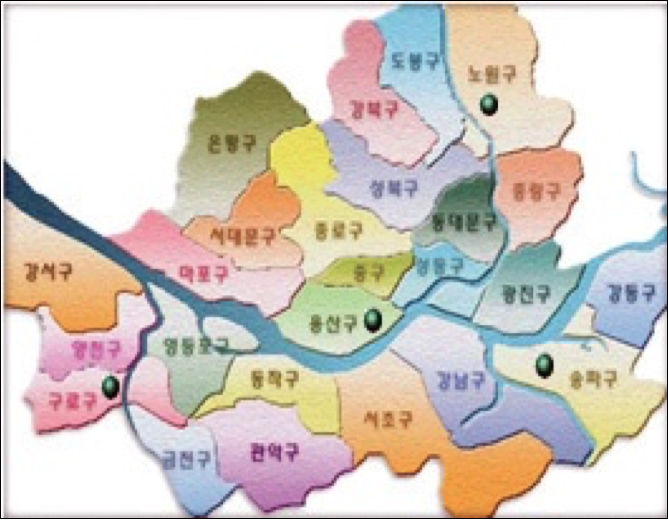
5) Acid Deposition Monitoring Network
Acid deposition refers to all the materials that fall from the atmosphere to the ground. Acid deposition can be divided into two types: wet deposition and dry deposition. Wet deposition includes acid rain, snow or fog. Dry deposition includes particle material PM2.5, gas material NO2, and ion SO42-. They fall to the ground from their aerosol status due to gravity.
The representative form of wet deposition is acid rain, and it is when the rain's pH is less than 5.6. Acid rain is created from sulfur oxides or nitrogenous compound reactions, and it is a long-distance pollutant as it can impact large areas. Acid rain can damage buildings, bridges and other important structures. And after prolonged exposure, children and elderly may suffer skin conditions. It damages the ecosystem because the acid rain inhibits water absorption of plantsand decomposition of organic materials, and pollutes the water.
SMG has been operating 10 acid deposition monitoring stations for monitoring from 1985 up until the present day. The station also analyzes ion composition, the major determinant of pH of acid rain and acidity of precipitation. The statistics are used for related policies. Currently, 8 stations other than clean areas (Bukhansan and Bangi) are located in residential areas. Bukhansan station is operated as the background monitoring station.
Figure 21. The Location of SMG’s Acid Rain Monitoring Stations
.png)
6) Photochemical Pollutant Monitoring Network
Large cities including Seoul record high population density and traffic, resulting in high density of ozone or nitrogen dioxide. Most of the ground-level ozone is created by photochemical reactions between nitrogenous compounds and Volatile Organic Compounds (VOCs). Therefore, it is very important to control nitrogen dioxide and VOCs, as a precursor, in order to control ozone density. VOCs are discharged from contamination sources, which creates secondary aerosol through photochemical reactions, increases the ozone density, leading to the increases in the cases of high density ozone and ozone 'watch' notifications.
Because of this, SMG has established 10 photochemical stations, and has measured elements every hour. This is done so as to monitor harmful VOCs, and to gain basic data to prepare effective policies.
Currently there are 5 VOCs stations (Gangseo, Gwangjin, Guro, Jongro, Bukhansan) and 5 BTEX stations (Songpa, Jungrang, Dongjak, Haengju, Segok) for continuous monitoring.

Because of this, SMG has established 10 photochemical stations, and has measured elements every hour. This is done so as to monitor harmful VOCs, and to gain basic data to prepare effective policies.
Currently there are 5 VOCs stations (Gangseo, Gwangjin, Guro, Jongro, Bukhansan) and 5 BTEX stations (Songpa, Jungrang, Dongjak, Haengju, Segok) for continuous monitoring.

Figure 22. Seoul City's Photochemical Pollutant Monitoring Network

7) City Background Quality Monitoring Network
As the Bukhansan monitoring station is located in a clean area, not much affected by pollutants, the from the Bukhansan stations are used to compare with Seoul's air quality. Compared to city air quality, Bukhansan area recorded low annual pollution levels in 2014 for all elements except the ozone. The clean areas show higher O3 density than the city is largely due to the high sunlight penetration ratio, resulting in high solar radiation. Therefore, the NO to NO2 ratio (NO2/NO) is higher than that of the city. Since NO is involved in O3 extinction and NO2 in O3 creation, which is why O3 equilibrium concentration is high in areas like Bukhansan station.
Figure 23. Air Pollution Comparison for Each Monitoring Network (in 2014)
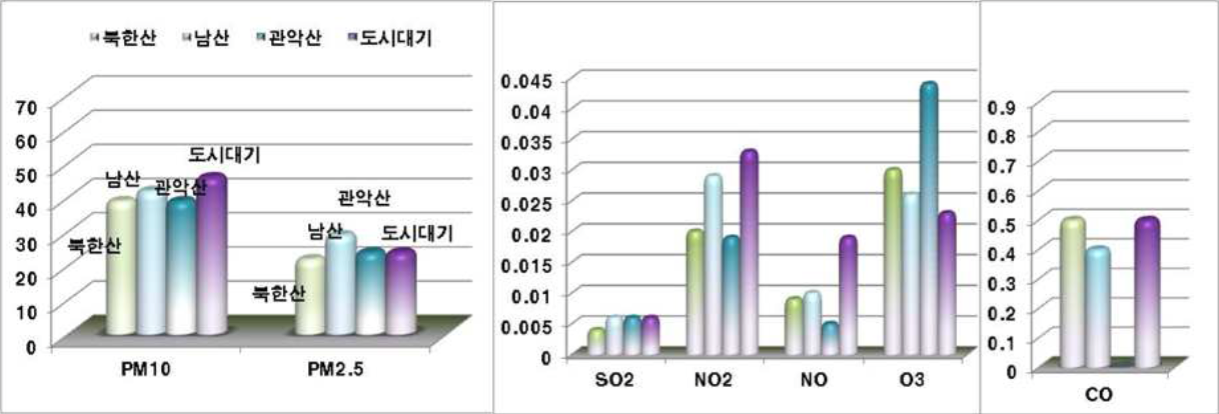
Technical Details
The air quality monitoring network mainly checks pollutants such as SO2, NO2, CO, O3, PM10, and PM2.5, and weather factors such as wind direction, speed, temperature, humidity, solar radiation and the UV radiation. The monitoring methods are as follows: Each element is measured once every hour. Fluorescence is used for sulfurous acid gas (SO2), non-dispersive infrared methods for carbon monoxide, the ultra-violate photometric method for the ozone and the gravimetric method for microdust. The materials are used for evaluating air pollution or designing air quality improvement plan.
Figure 24. Collection and Distribution System of Air Quality Data
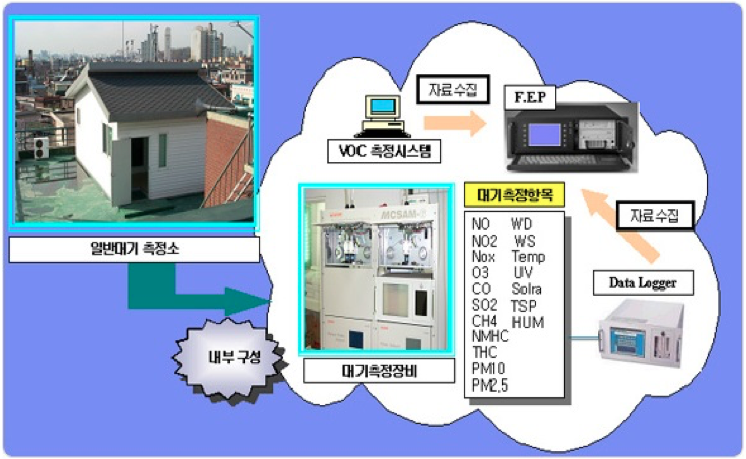
Source: http;//env.seoul.go.kr
As for deciding the locations for pollutants sampling, there are various ways: a)calculating population and density, b)a TM coordinate system that creates grid for each a 2-3 kilometers and selects a point in each area, c)using a center of an area and straight lines in each direction to select crossing points as station, or d) using a formula according to pollution level of target areas.
Figure 25. Analytic Device within Air Quality Monitoring Station
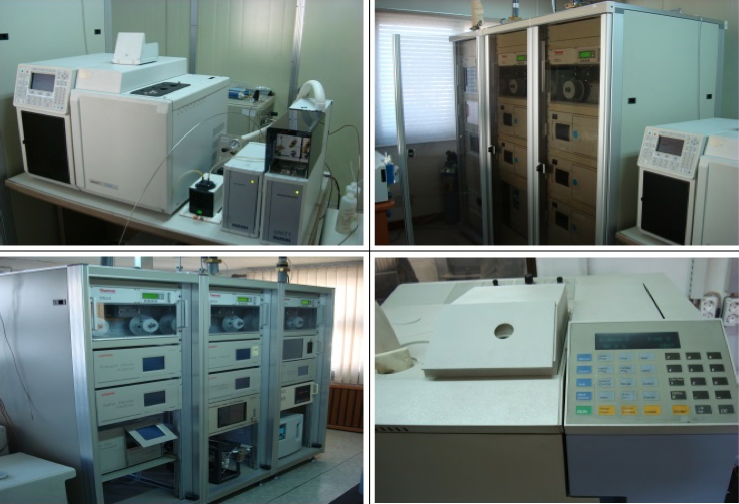
Source: Seoul Development Institute. 2008. "Study on Approaches to Effectively Link Traffic and Air Pollution Monitoring Data"
In order to increase the accuracy of the monitoring networks, as well as contribute to the effective operation, SMG selects, installs and operates monitoring stations at locations that could offer the area’s representative datawhile reflecting the environmental elements, population distribution, and distances between stations so the operation, repair and access is carried out most efficiently. Moreover, equpments within the monitoring station are placed a certain distance away from one another to minimize mutual interference.
When the location of a monitoring station is considered to be inappropriate or the station's building is being removed, the station should also be relocated. New locations are decided within the closest possible distance from the original place. The final location is decided after considering the opinions of the evaluation group of the air pollution monitoring network.
Policy Effects
SMG can secure basic data including cause analysis needed to come up with measure to improve air quality and understand the trends of air quality elements such as microdust, ultrafine particles or nitrogen dioxide, based on the constructed air quality monitoring system. Based on the collected material, SMG protects citizens' health by forecasting or warning the level or density of microdust, yellow dust and the ozone. Automatically collected data on air pollution are uploaded and released in real-time on the website or its mobile applications of the Air Environment Information. This is to improve the transparency of administration, and meet the citizens' right to be informed.
SMG has been operating the microdust forecast and warning system since February 2005, according to the Ordinance on the Microdust Forecast and Warning. Moreover, the city has also been operating the ultrafine particle (PM2.5) warning system since October 2013, contributing to the protection of citizens' health.
Fine dust forecasts in 2014 showed a high accuracy rate of 70.5%: 68.5% for for the forecast made a day before, and 72.6% for the forecast made for the day. Microdust forecasts are provided to related organizations such as local governments, police, the Office of Education, and citizens who wish to receive the information via SMSs (text message). There were 2 microdust watches, 6 ultrafine particle watches, and 14 (preliminary) watches released in 2014.
SMG has been operating the microdust forecast and warning system since February 2005, according to the Ordinance on the Microdust Forecast and Warning. Moreover, the city has also been operating the ultrafine particle (PM2.5) warning system since October 2013, contributing to the protection of citizens' health.
Fine dust forecasts in 2014 showed a high accuracy rate of 70.5%: 68.5% for for the forecast made a day before, and 72.6% for the forecast made for the day. Microdust forecasts are provided to related organizations such as local governments, police, the Office of Education, and citizens who wish to receive the information via SMSs (text message). There were 2 microdust watches, 6 ultrafine particle watches, and 14 (preliminary) watches released in 2014.
Challenges and Solutions
Air pollution monitoring stations installed in Korea have contributed greatly to our understanding of domestic air pollution, and the creation of air quality improvement plans. SMG’s monitoring stations are installed in a more concentrated fashion compared to other areas, and this is playing an important role in evaluating air pollution policies and preparing future plans.
There are various challenges in terms of securing locations for air pollution monitoring networks due to the characteristics of Seoul as metropolis. Since the stations are mainly installed on top of public offices or schools, it is questionable whether the statistics truly and accurately reflect the area's air quality. Some stations are blocked by large apartment complexes or commercial buildings.
For this, alternative locations must be found, and mobile air monitoring vehicles can also monitor air quality for certain durations and then the station can be moved after reliable results are obtained from alternative locations.
Moreover, there have been efforts have been made to measure harmful carcinogenic pollutants, albeit low density. Strenuous efforts are made to establish relevant policies and implement them to secure various monitoring elements and to accurately evaluate the impact of the pollutants on the citizen’s health and to enhance the reliability of the stations.
There are various challenges in terms of securing locations for air pollution monitoring networks due to the characteristics of Seoul as metropolis. Since the stations are mainly installed on top of public offices or schools, it is questionable whether the statistics truly and accurately reflect the area's air quality. Some stations are blocked by large apartment complexes or commercial buildings.
For this, alternative locations must be found, and mobile air monitoring vehicles can also monitor air quality for certain durations and then the station can be moved after reliable results are obtained from alternative locations.
Moreover, there have been efforts have been made to measure harmful carcinogenic pollutants, albeit low density. Strenuous efforts are made to establish relevant policies and implement them to secure various monitoring elements and to accurately evaluate the impact of the pollutants on the citizen’s health and to enhance the reliability of the stations.
